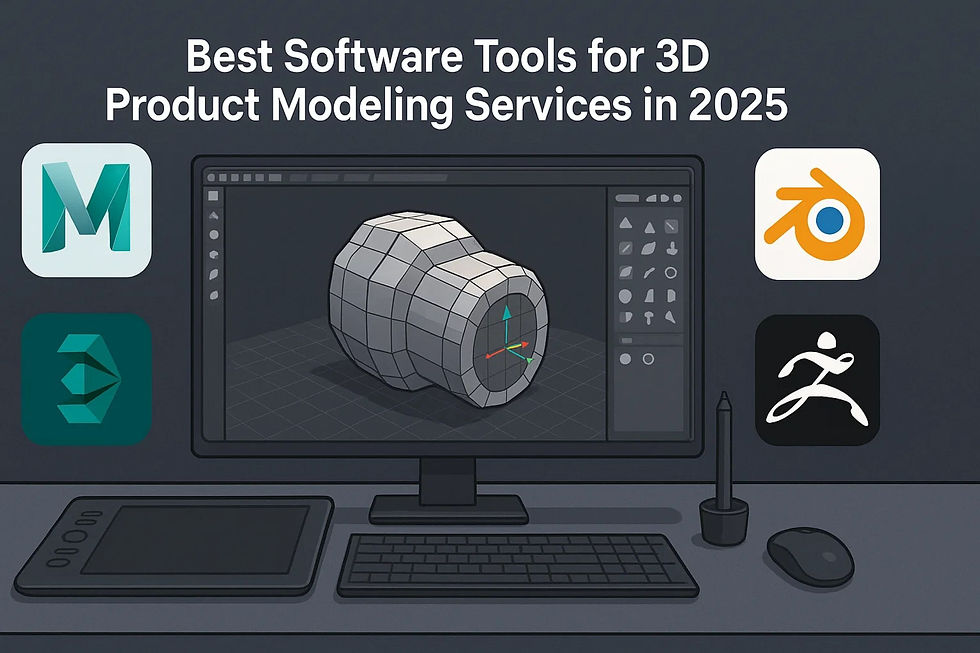Optimize 3D Models for 3D Printing and AR
- Hemant vizent
- Jun 18
- 4 min read
3D Models for 3D Printing
In the fast-evolving world of 3D Modeling Services, it’s no longer enough to just create high-quality models — they must also be optimized for specific applications like AR 3D modeling and 3D modeling for 3D printing. Whether you're a 3D Model Maker for 3D Printer or working on AR Product Visualization, the way you optimize your 3D model can make or break its functionality and performance.
In this blog, we’ll explore the best practices to optimize 3D models for both augmented reality (AR) and 3D printing, ensuring that your designs meet industry standards, print reliably, and deliver seamless Virtual Reality 3D Modeling experiences.
Why Optimization Matters in 3D Modeling Services
Optimizing a 3D model is not just about reducing file size; it’s about improving performance, compatibility, and user experience. For example:
In AR 3D Modeling, optimization reduces lag during real-time rendering.
In 3D Modeling for 3D Printing, it ensures dimensional accuracy and structural integrity.
In VR 3D Modeling, it boosts performance across various platforms and devices.
Failing to optimize leads to broken prints, app crashes, or laggy AR/VR visuals — all of which can ruin your product’s impact.
1. Choose the Right File Format for Your Purpose
Best File Types for 3D Model Augmented Reality and AR Product Visualization
When delivering models for AR Product Visualization, formats like3D Model Augmented Reality in GLB, USDZ, or FBX are commonly used. These formats support animations, textures, and are lightweight — ideal for mobile AR applications.
Best File Types for 3D Modeling for 3D Printing
STL is the most popular, but 3MF provides better metadata support.
Pro Tip: Always export your files in the format that aligns with the intended platform — this avoids unnecessary conversions and potential geometry errors.
2. Simplify Geometry Without Losing Quality
High-poly models are great for renders but not practical for AR or 3D printing. Whether you’re delivering AR 3D Modeling content or prototyping with 3D product modeling services, polygon count matters.
For AR and Virtual Reality 3D Modeling
Use low-poly modeling techniques while preserving details using normal maps and textures.
Avoid complex boolean operations and excessive subdivision surfaces.
For 3D Printing
Ensure the model is manifold (watertight), and reduce geometry that doesn’t affect the print (like internal faces).
Bonus Tip: Use tools like Blender’s Decimate Modifier, Autodesk MeshMixer, or ZBrush to reduce mesh density.
3. Check and Fix Model Topology
Poor topology leads to problems in both rendering and printing.
AR/VR and 3D Model Augmented Reality Considerations
Remove non-manifold edges and stray vertices.
Ensure quads are used over triangles when working with rigged or animated models.
3D Modeling for 3D Printing Tips
Ensure closed geometry (no holes).
Avoid intersecting faces or floating parts.
4. Optimize Texture Maps and Materials
In AR Product Visualization and VR 3D Modeling, texture sizes directly impact load times and performance.
Texture Optimization for AR and Virtual Reality 3D Modeling
Compress textures using WebP or JPG formats.
Minimize the number of materials; combine textures when possible.
3D Printing Tip
While 3D printers don’t use textures, full-color 3D printers (like those from Stratasys or Mimaki) may require color textures embedded in formats like VRML or 3MF.
5. Scale and Unit Consistency Across Platforms
In AR and VR Modeling
Different platforms interpret scale differently. For example, an object meant to be 1 meter tall might appear tiny or oversized in an AR app.
In 3D Modeling for 3D Printing
Ensure your model matches the unit system used by the printer software (millimeters are most common). Most slicers allow unit adjustment, but incorrect scale leads to wasted material or unusable prints.
6. Hollow Models Where Appropriate
3D Model Maker for 3D Printer Optimization Tip
If your object doesn’t need internal support:
Make it hollow and add drain holes to release uncured resin (especially in SLA printing).
This also makes your models lighter, faster, and cheaper to print — a win-win for any 3D Model Maker for 3D Printer.
7. Rigging and Animation for AR/VR Models
If your AR 3D Modeling includes interactive or animated content, the rigging needs to be clean and light.
Avoid overcomplicating skeletons.
Limit joint counts for mobile performance.
Bake animations when possible.
This ensures smoother experiences in real-time Virtual Reality 3D Modeling engines like Unity or Unreal Engine.
8. Test Rigorously on Target Platforms
An essential but often ignored step in 3D Modeling Services is platform-specific testing.
Test for AR/VR
Evaluate loading speed, rendering quality, and responsiveness.
Test for 3D Printing
Load your model in slicing software like Cura or PrusaSlicer.
Check for overhangs, supports, and print time estimation.
9. Use the Right Tools and Plugins
Efficient 3D model makers for 3D printers and AR use specialized tools to streamline optimization:
You can also find plugins that directly check printability, polycount, and texture maps within your 3D software.
10. Keep a Library of Templates
For example:
Template base meshes (like chairs, vehicles, etc.)
Pre-optimized material libraries
Slicing profiles for different printer types
This speeds up workflow and ensures consistency in large-scale 3D product modeling services.
Conclusion: Optimization Is the Key to Versatility
Whether you're developing 3D models for augmented reality, immersiveVirtual Reality 3D Modeling, or 3D printing prototypes, optimization transforms your design from just a file to a functional, usable asset. By applying the best practices outlined here — from simplifying geometry and textures to validating your models and adjusting scale — you can significantly enhance performance and usability across platforms.
In today’s competitive market, investing in expert 3D Modeling Services isn’t just about quality — it’s about optimization, compatibility, and readiness for real-world applications. The more efficient your model, the better the results in AR product visualization and 3D printing production.






Comments